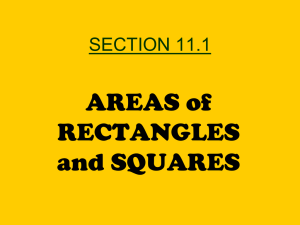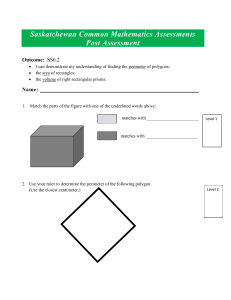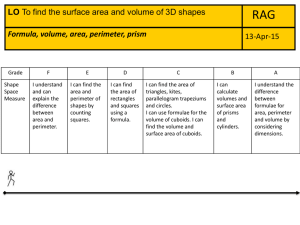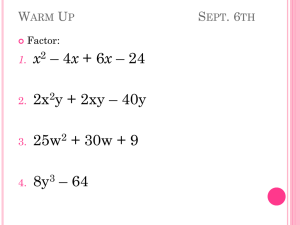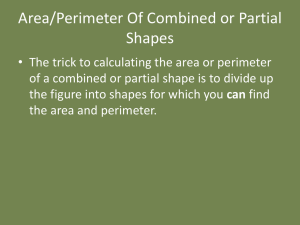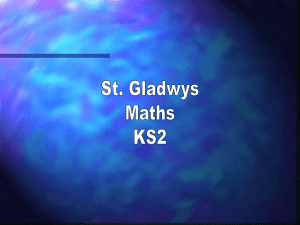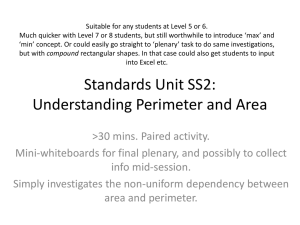Leveled Indicators
advertisement
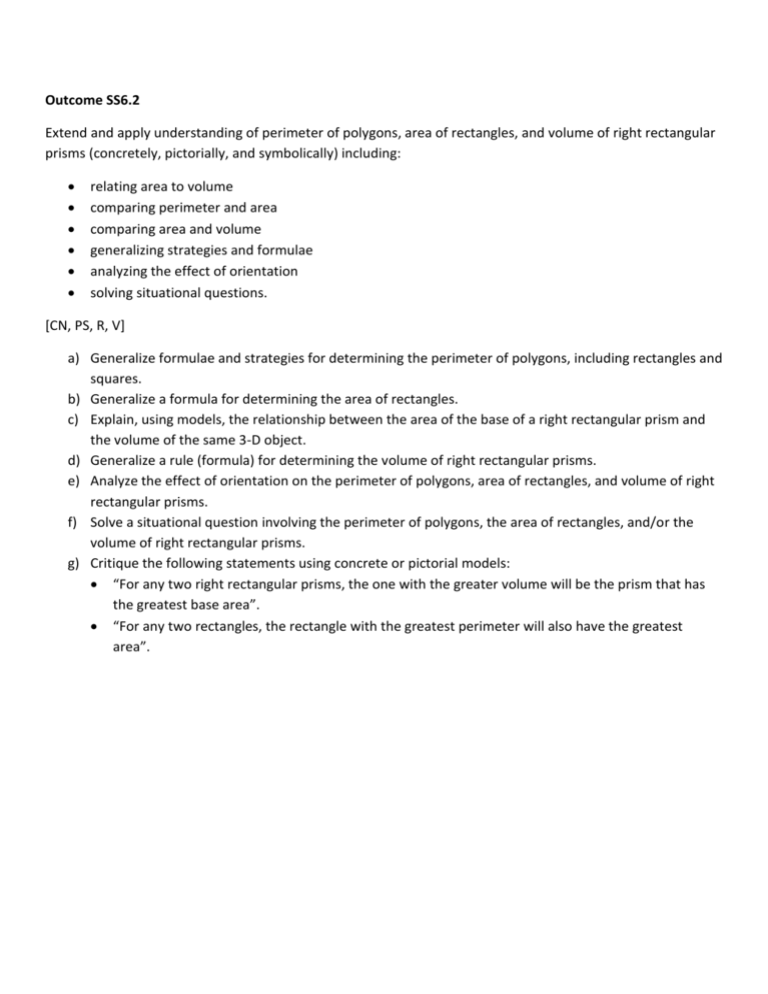
Outcome SS6.2 Extend and apply understanding of perimeter of polygons, area of rectangles, and volume of right rectangular prisms (concretely, pictorially, and symbolically) including: relating area to volume comparing perimeter and area comparing area and volume generalizing strategies and formulae analyzing the effect of orientation solving situational questions. [CN, PS, R, V] a) Generalize formulae and strategies for determining the perimeter of polygons, including rectangles and squares. b) Generalize a formula for determining the area of rectangles. c) Explain, using models, the relationship between the area of the base of a right rectangular prism and the volume of the same 3-D object. d) Generalize a rule (formula) for determining the volume of right rectangular prisms. e) Analyze the effect of orientation on the perimeter of polygons, area of rectangles, and volume of right rectangular prisms. f) Solve a situational question involving the perimeter of polygons, the area of rectangles, and/or the volume of right rectangular prisms. g) Critique the following statements using concrete or pictorial models: “For any two right rectangular prisms, the one with the greater volume will be the prism that has the greatest base area”. “For any two rectangles, the rectangle with the greatest perimeter will also have the greatest area”. Level Scale Pre-Requisite Knowledge Descriptor Students who are not able to be independently successful with level 1 questions will be given an E. Indicators Student-Friendly Language Addition and multiplication of whole and decimal numbers. Linear measurement. NN6 – Checkpoint 11 The student understands that a measurement unit is an amount, rather than an object, a shape, or a mark on a scale. NN6 – Checkpoint 12 The student uses multiplication to find perimeter, area, and volume. 1 B - Beginning There is a partial understanding of some of the simpler details and processes. Prior knowledge is understood. 2 A– Approaching No major errors or omissions regarding the simpler details or processes, but assistance may be required with the complex processes. 3 M – Meeting No major errors or omissions regarding any of the information and/or processes that were explicitly taught. This is the target level for proficiency. Knowledge and Comprehension Students who are successful with level 1 questions or those who are successful with level 1 or 2 questions with assistance will be given a B. Applying and Analysing Students who are able to be successful with level 1 and level 2 questions, or those who are successful with higher-level questions with assistance, will be given an A. Evaluating and Creating Students who are independently successful with level 3 or level 4 questions are given an M. a) Generalize formulae and strategies for determining the perimeter of polygons, including rectangles and squares I know how to find the perimeter of any given shape. b) Generalize a formula for determining the area of rectangles. c) Explain, using models, the relationship between the area of the base of a right rectangular prism and the volume of the same 3-D object. I understand the formula for the area of a rectangle. d) Generalize a rule (formula) for determining the volume of right rectangular prisms. e) Analyze the effect of orientation on the perimeter of polygons, area of rectangles, and volume of right I understand the formula for the volume of a rectangular object. I understand the differences and relationships between perimeter and area. I understand the relationship between the area of the base of an object and the volume. I know that no matter how an object is sitting, the perimeter, area and volume will remain the same. rectangular prisms. f) Solve a situational question involving the perimeter of polygons, the area of rectangles, and/or the volume of right rectangular prisms. g) Critique the following statements using concrete or pictorial models: “For any two right rectangular prisms, the one with the greater volume will be the prism that has the greatest base area”. “For any two rectangles, the rectangle with the greatest perimeter will also have the greatest area”. 4 In addition to level 3 performance, indepth inferences and applications go beyond what was explicitly taught. Students successful at level 4 will receive supplementary comments specific to their achievement in addition to the M. I can solve problems involving perimeter, area and volume. I can apply my knowledge of perimeter, area, and volume to real-life problems or occurrences. Outcome SS6.2 Extend and apply understanding of perimeter of polygons, area of rectangles, and volume of right rectangular prisms (concretely, pictorially, and symbolically) including: relating area to volume comparing perimeter and area comparing area and volume generalizing strategies and formulae analyzing the effect of orientation solving situational questions. Meeting Approaching I understand the formula for the area of a rectangle. Beginning I know how to find the perimeter of any given shape. I understand the differences and relationships between perimeter and area. I understand the relationship between the area of the base of an object and the volume. I understand the formula for the volume of a rectangular object. I know that no matter how an object is sitting, the perimeter, area and volume will remain the same. I can solve problems involving perimeter, area and volume. I can apply my knowledge of perimeter, area, and volume to real-life problems or occurrences.
